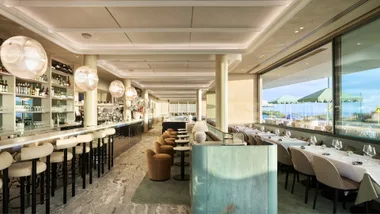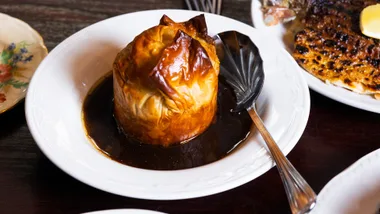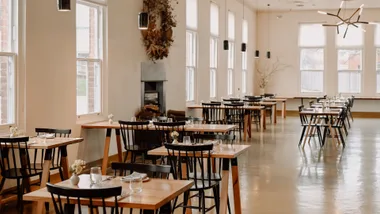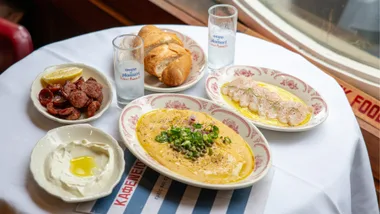“The highest compliment you can give a Korean cook is to say the food has a ‘gamchilmat’. This describes food that wraps around the palate, enveloping the whole mouth with flavour. There is no equivalent term in English, and here we begin to see the delicate subtleties of Korean food.” – Korean Food Guide in English, The Korea Foundation (eds).
Chances are you’ve eaten some decent Korean food, particularly if you happen to be Korean. But Korean hasn’t set Australia on fire in quite the same way as Italian cooking, its restaurants haven’t influenced our top chefs like those of Spain, and its flavours haven’t become as ubiquitous as Thai or Chinese. At least until now.
People are discovering the crunch of pickled radish with late-night fried chicken in Brisbane, the squish and double-consonant thrill of tteok rice cakes in Melbourne and, yes, the gamchilmat of jjigaes in Sydney. They’re having that happy revelation that I hold so dear, the one where you realise it’s perfectly legit to ask for seconds (and thirds) of banchan, the side dishes that sprout mushroom-like from the bigger plates on just about every Korean table.
What’s more, Korean restaurant culture is now established enough in Australia that it has begun producing interesting local strains. The locus of the most dynamic Korean cooking in the country is Sydney, and at the pointy end of that scene you’ll find Moon Park and Danjee, two restaurants distinctly different from each other, but also different again to anything you’ll find in Seoul or Los Angeles, the twin capitals of Korean dining.
Moon Park is Eun Hee An, Ben Sears and Ned Brooks’s baby. They’ve opened the place on the smell of a sesame-oily rag above a furniture shop in Redfern. It’s not what you’d call glamorous. Noise and ventilation can, at times, be an issue, and there’s more than a bit of undergraduate-dorm feel to it. (The Lego version of the Sungnyemun gate in the dining room is an endearing touch.) But there’s a let’s-just-do-it brio to the whole enterprise that’s hard not to like.
I’d happily crawl over the smoking ruins of a dozen million-dollar fit-outs to get to food and booze with as much guts and integrity as what they serve at Moon Park. Sitting on the balcony with a cold glass of something watching the bats wheel over Redfern Park is certainly no bad thing.
It’s food that’s polished, poised and frequently quite dazzling in its presentation. Where some of it is plated in a perfectly plain manner (crisp beef jerky brushed with sesame oil, say, or crisp tteok rice cakes crusted in peanut, both from the list of anju, or drinking snacks), many of the dishes show the verve and chromatic sparkle that so marked the food in the last incarnation of Claude’s, when Sears was head chef, working alongside Hee An. They tweak the Korean palette just as they pay homage to its palate, scattering a kimchi-spiked salad of heirloom tomatoes and acorn jelly with nasturtium leaves and petals, and piling sunflower seeds, society garlic flowers and lemon zest atop yukhoe, Korea’s beef tartare, paired here with scorched onions under leaves of preserved shiso. Sea urchin roe, meanwhile, creamy on a crisp flax cracker, is garnished with the pretty blue of borage blossoms.
These bosky tributes, though striking, are very much of a piece with traditional Korean food in the sense that the bounty of the forests is keenly appreciated in Korea. I have happy memories of a lunch at Baru, a Buddhist temple restaurant in Seoul, that was almost Noma-esque in its virtuosic presentation of leaves, petals, pollen, roots and nuts.
Back in Redfern, things get even more dramatic with the octopus, as they so often do. Curled tentacle tips and hoods of small octopus from Coffin Bay share the plate with potato chips, drops of a saline, inky dashi-based sauce and swatches of the tiger-striped grained kombu now so beloved by the nation’s top chefs. Arresting and brilliant.
The menu’s two chicken dishes have very different aesthetics: the fried chicken is pretty straight, only the addition of shrimp sauce to the brining mixture complicating the basic satisfactions of crunch and give, with cubes of pickled daikon and a scattering of black sesame as a final flourish. Imjasutang, on the other hand, takes a royal summer chicken dish and remixes it with a firmly contemporary twist: pieces of juicy cold poached chicken in a thin sesame and pine-nut sauce are contrasted by discs of raw mushroom, little dollops of date purée and pickled rose petals. It’s beautiful, though in terms of taste I wonder if it hews a little too closely to the original dish’s reputation as being a food for invalids. I like them both, but I know which one I’ll be ordering next time I’m in for a beer.
Or a Cotat Sancerre. Or a Salomon Undhof riesling vinified in a terracotta amphora. Or The Prince in His Caves, a sauv blanc from The Scholium Project, an American operation whose wines The New York Times describes as sometimes exquisite, sometimes “shocking and undrinkable”, but always fascinating. You can thank sommelier-manager Ned Brooks for this, and for the cans of OB Lager. His drinks list, and the way it’s served (with the significant assistance of gun former Claude’s manager Abby Meinke), are a big part of what makes Moon Park special.
The strike rate here is impressive. The bibim updates the classic Korean rice bowl without getting too overtly tricky: the piles of crabmeat, corn, squares of nori, barley, rice, green onion and gratings of cured egg yolk are there for mixing with gochujang, Korea’s mild chilli and soybean sauce, and the result is light, bright and fluffy, but also deeply savoury. On the sweet side, Hee An and Sears offer only a couple of desserts, but they make them count. The “Moon Pie” is blobs of torched marshmallow and ginger jelly sprinkled with cracker crumbs, while their take on patbingsu is a figleaf milk-ice with little doughnuts and a dash of omija, a Korean fruit tea. They’re both musts.
Danjee comes at things from a different tack.
Its location is marginally less obscure, in an historic building down the alleyway beside the George Street cinemas. It’s owned by Kyu-Seok Jo, a veteran local restaurateur who runs Madang, the landmark eatery on Pitt Street’s Korean strip. In opening what he wants to make “Korean upgraded”, he enlisted the aid of his son, Peter Jo, who counts Berta, 121BC and Momofuku among his recent employers.
Jo the younger has since moved on, but his chief contribution, the wine list, remains. Rare is the Korean restaurant that has a cellar packed with the likes of vin jaune, aligoté, Long Island tocai Friulano and Canberra shiraz-viognier; finding two in the same city is downright uncanny. (Lucky us.) It’d be easy to dismiss (or simply enjoy) it as a list just comprising what Peter Jo likes drinking, but he makes it work. The pinot blanc offered by the glass, from Marlborough’s Pyramid Valley, works its supple, minerally magic around a salad of crisp fried rice, radicchio and strips of pumpkin as readily as it does an entrée version of bo ssäm – slices of pork belly simmered tender, which you wrap in sheets of pickled daikon with oysters and a dollop of kimchi. If you just want a Korean beer or some makgeolli, the highly drinkable cloudy Korean rice booze that’s like the rustic love child of a beer and a bowl of congee, they’re available too (as they are at Moon Park).
Danjee sits apart from Koreatown. It still has the K-pop soundtrack, the napkins are paper, the plates are melamine, the lighting is a bit bright, and the language skills of the floor staff are uneven, but call buttons on the tables and advertisements for beer are (pleasantly) notable in their absence. They don’t do fried chicken but, unlike Moon Park, they offer banchan in profusion. These side dishes vary from time to time and are rendered with care, whether it’s the squares of green bean jelly dolloped with chilli or the briskly peppery pickled daikon.
The restaurant is split across two sections, with a newer, glassed-in building for the barbecue tables. The grills are gas rather than charcoal, but the quality of the ingredients (as generally seems to be the case here) is a cut above. Fingers of beef intercostal, skirt, or shreds of soy-steeped duck, hot from the grill and wrapped in shiso leaves, can only be improved by the addition of a splash of Heathcote shiraz. (Or Elena Walch lagrein. Or Crozes-Hermitage.)
For the most part what puts Danjee ahead of the pack is its superior execution of the more familiar parts of the Korean canon. Here, ko gi jeon – shiso leaves, small patties of beef, and green chilli battered in an omelette-like fry – are light, hot and golden. The potato starch noodles, called jap chae, are stir-fried with shred of beef and come to the table smoky. Consider hwae dup bap, a bibim-style dish in which the rice is topped with raw salmon and kingfish. It’s both light and hearty, spicy with gochujang and leavened with chrysanthemum leaves, red onion and pear.
Chestnuts accompany the braised beef ribs, and dates and gingko nuts are slow-cooked with the oxtail. There’s savoury depth in the stews, and plenty of spice in the bul dak ( “fire chicken”), an OTT extravaganza of rice cakes, mozzarella and cayenne that’s come uncut from Madang, where it has a cult following.
For dessert, close with a tea made from dried Jerusalem artichoke, or mandarin peel.
The two restaurants are markedly different in their approach, but their aims are the same: to raise both the quality and status of Korean cooking in Australia. Along the way, they’ve also managed to advance the cause of outré, natural-leaning wine lists in Asian restaurants. The delicate subtleties of Korean food have few better local champions.

Danjee, Sydney











